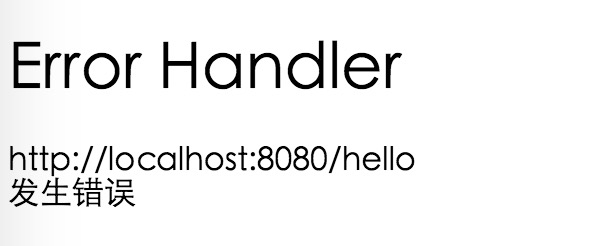我们在做Web应用的时候,请求处理过程中发生错误是非常常见的情况。Spring Boot提供了一个默认的映射:/error,当处理中抛出异常之后,会转到该请求中处理,并且该请求有一个全局的错误页面用来展示异常内容。
选择一个之前实现过的Web应用(Chapter3-1-2)为基础,启动该应用,访问一个不存在的URL,或是修改处理内容,直接抛出异常,如:
@RequestMapping("/hello")
public String hello() throws Exception {
throw new Exception("发生错误");
}
此时,可以看到类似下面的报错页面,该页面就是Spring Boot提供的默认error映射页面。
统一异常处理
虽然,Spring Boot中实现了默认的error映射,但是在实际应用中,上面你的错误页面对用户来说并不够友好,我们通常需要去实现我们自己的异常提示。
下面我们以之前的Web应用例子为基础(Chapter3-1-2),进行统一异常处理的改造。
- 创建全局异常处理类:通过使用
@ControllerAdvice定义统一的异常处理类,而不是在每个Controller中逐个定义。@ExceptionHandler用来定义函数针对的异常类型,最后将Exception对象和请求URL映射到error.html中@ControllerAdvice class GlobalExceptionHandler { public static final String DEFAULT_ERROR_VIEW = "error"; @ExceptionHandler(value = Exception.class) public ModelAndView defaultErrorHandler(HttpServletRequest req, Exception e) throws Exception { ModelAndView mav = new ModelAndView(); mav.addObject("exception", e); mav.addObject("url", req.getRequestURL()); mav.setViewName(DEFAULT_ERROR_VIEW); return mav; } } - 实现
error.html页面展示:在templates目录下创建error.html,将请求的URL和Exception对象的message输出。<!DOCTYPE html> <html> <head lang="en"> <meta charset="UTF-8" /> <title>统一异常处理</title> </head> <body> <h1>Error Handler</h1> <div th:text="${url}"></div> <div th:text="${exception.message}"></div> </body> </html>启动该应用,访问:
http://localhost:8080/hello,可以看到如下错误提示页面。通过实现上述内容之后,我们只需要在
Controller中抛出Exception,当然我们可能会有多种不同的Exception。然后在@ControllerAdvice类中,根据抛出的具体Exception类型匹配@ExceptionHandler中配置的异常类型来匹配错误映射和处理。

